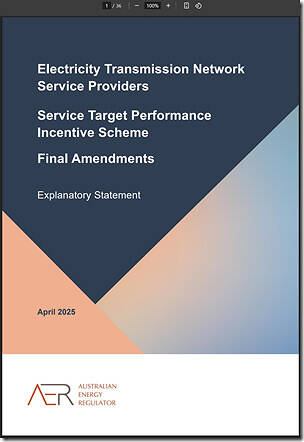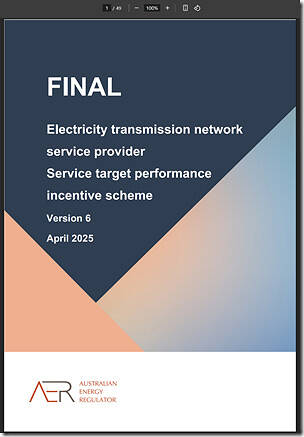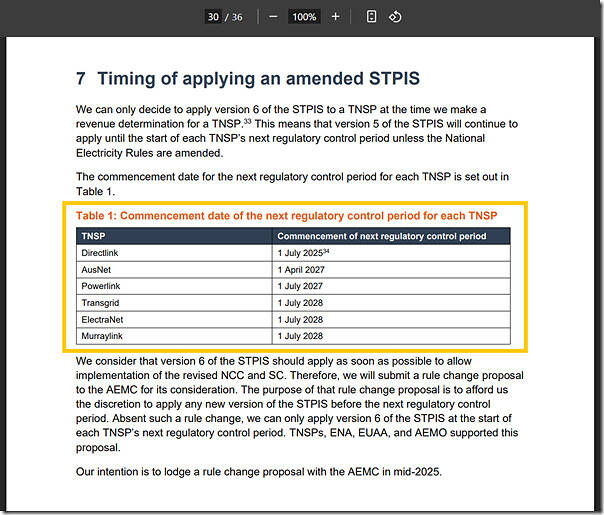A short, belated and backdated article to note that on Thursday 17th April 2025, the AER published its Final Decision on the Service Target Performance Incentive Scheme (STIPS) for transmission companies.
For our ease of future reference, we’ve referenced them here:
|
AER Explanatory Statement Thu 17th April 2025 |
AER version 6 if the STIPS Thu 17th April 2025 |
|---|---|
|
You can download the 36-page PDF of the Explanatory Statement here:
|
You can download the 49-page PDF of v6 of the TNSP STIPS here:
|
|
I’ve skimmed the Explanatory Statement, and have lifted out some context below, for our ease of future reference. |
For our future reference, the main parts in this Scheme document pertaining to the MIC are:
|
Skimming the Explanatory Statement
Within the Explanatory Statement document, the following jumped out to me early on in the document:
[p4/36] ‘Much of the reason why the STPIS is no longer working as intended is due to the current energy transition, which is changing the way electricity is generated and transported. When the STPIS was introduced in 2007, over 80% of electricity was generated using fossil fuels. Now renewables make up around 40% of output and 60% of generation capacity. This move from more centrally located thermal generation to more geographically dispersed and weather dependent fuel sources creates new demands on the transmission network and has implications for how TNSPs manage their assets’
… which is what we’ve written about before plenty of times here on WattClarity®
… and …
[p5/36] ‘However, there is consensus that the MIC is no longer fit for purpose. High investment in renewables, increased congestion on radial lines, and more outages associated with high transmission investment, has contributed to a significant increase in the number of MIC events over the past five years. Now TNSPs often face maximum penalties regardless of their actions.
Most stakeholders want to replace the current MIC with a more effective variant based on financial incentives to drive the conduct and behaviour of TNSPs in planning outages. The MIC is currently no longer fit for purpose, and not providing the correct incentives. Accordingly, we have suspended the MIC, and will establish a working group to recommend alternatives to the MIC. The working group will also consider what other mechanisms might be appropriate to achieve the objective of the MIC, for example, imposing conduct obligations. The working group will report its findings to the AER for consideration. We intend to establish the working group as soon as practicable in 2025, with the aim of it providing recommendations to the AER in mid to late 2026. The working group will include representatives of AEMO, the AEMC, TNSPs, generators and consumers.
Consistent with our proposed amendments, we will also improve transparency about the TNSPs’ planned outage management performance by collecting new data and reporting annually. We will focus on how TNSPs use demand and supply forecasts to schedule and reschedule outages. We will also assess planned outages that occur at times of extreme spot market prices.’
… and …
[p7/36] ‘The STPIS can only be applied at the time we make a revenue determination for a TNSP.3 This means that version 5 of the STPIS will continue to apply until the start of each TNSP’s next regulatory control period unless the National Electricity Rules (NER) are changed.
Consistent with our November 2024 Explanatory Statement on our proposed amendments we will also submit a rule change proposal to the AEMC to afford us the discretion to apply an amended STPIS during a regulatory control period, rather than only being able to do so as part of a revenue determination. TNSPs, ENA, EUAA, and AEMO supported this proposal.
Importantly, the rule change would enable all market participants, including consumers, to reap the benefits of improvements to the NCC and the SC sooner than would have otherwise been the case. We have established that the MIC is no longer fit for purpose. The rule change would also allow for its immediate and simultaneous suspension across all TNSPs.’
Chapter 4 (from p13/36) has more discussion.
Chapter 7 (p30/36) contains this useful table that answers questions about (at the latest – notwithstanding the Rule Change noted above) when version 6 would start applying:
We note in the following that TasNetworks is not listed, for some reason … our understanding is that the commencement date for the next regulatory period would be 1st July 2029 (i.e. they are less than 1 year into their current period).
Appendix A contains a ‘summary of stakeholder submissions’ … but the detailed submissions are all collated here.
Media Release
To mark this event, the AER published a Media Release titled ‘AER publishes final decision on the Transmission STPIS Review’ which says:
‘The STPIS is an important regulatory mechanism that incentivises transmission network service providers (TNSPs) to:
(a) reduce the number and duration of outages (the service component, SC),
(b) schedule outages for when they have the least impact on wholesale market prices (the market impact component, MIC), and
(c) undertake low-cost projects which improve the capability of the existing network (the network capability component, NCC).
We have now completed our comprehensive review of all components of the STPIS.
Throughout our review, networks and other stakeholders raised concerns that in its current form elements of the STPIS are no longer working as intended. This is due to the current transition to renewable energy sources, which is changing the way electricity is generated and transported.
In arriving at our final decision, we considered that while the STPIS remains an important regulatory tool, stakeholders’ concerns are credible and changes to the STPIS are required to accommodate these developments. These amendments to the scheme will continue to ensure TNSPs are operating their networks in the best interests of market participants and consumers.
Our final positions are to:
(a) amend the loss of supply event frequency parameter of the SC
(b) suspend the MIC, and we will explore developing an effective alternative by establishing a working group with AEMO and key stakeholders, and
(c) amend the NCC to make it a more streamlined process.’
There is more information available under the sub-site for the Review here.
That’s all, for now…





Be the first to comment on "AER suspends the MIC component of STIPS following review"